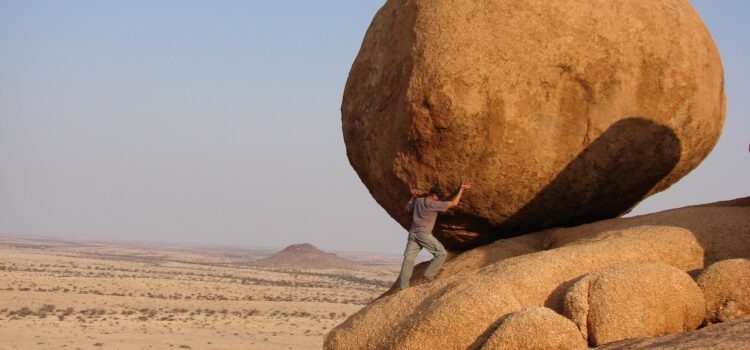

This article is an excerpt from the Shortform book guide to "Linchpin" by Seth Godin. Shortform has the world's best summaries and analyses of books you should be reading.
Like this article? Sign up for a free trial here.
Want an overview of Linchpin by Seth Godin? What is the “linchpin mindset” and why should you practice it?
In Linchpin, Seth Godin aims to inspire readers who have lost their motivation at work. Godin explains how adopting a linchpin mindset brings you more fulfillment in your career by empowering you to develop and use your unique skills at work.
Keep reading for a brief overview of Linchpin by Seth Godin.
Linchpin by Seth Godin
Do you feel uninspired at work? Do you dream of making a positive impact on the world but doubt that you’re good enough to do so? In Linchpin by Seth Godin, he explains how anyone can choose to create work that changes the world by becoming a “linchpin” whose unique skills hold their organization together. Godin asserts that becoming a linchpin is not only the path to a fulfilling life and career but also necessary for career security in today’s tumultuous job market.
Godin is an entrepreneur and author of 20 best-selling books on marketing, leadership, and creativity. Linchpin, his 13th book, was published in 2010 and has become one of Godin’s most popular works.
Godin states that Linchpin isn’t meant to be a guide to business success in the traditional sense: Rather than give you a step-by-step plan to achieve success as an entrepreneur or marketer, Linchpin is meant to teach you a new way of thinking that will empower you to live up to your full potential, however you define that for yourself. You don’t have to quit your job or start your own business to be a linchpin—no matter what your life looks like, you can find fulfillment by applying the linchpin mindset to your work.
(Shortform note: Many authors similarly suggest focusing on changing your mindset rather than following steps to fit your life into a specific mold. But why teach you how to think rather than how to act? In Atomic Habits, James Clear explains that the only way to maintain healthy habits indefinitely is to integrate them into your identity. In other words, you adopt the mindset that you are the type of person who practices good habits. Without this identity, you’ll have to exert much more effort to motivate yourself to act, and you’re likely to drop good habits when you run out of discipline. For this reason, Godin doesn’t just want to tell you what to do to be a linchpin—he wants you to believe that you are a linchpin.)
What Is a Linchpin Mindset?
In Linchpin, Seth Godin explains that the defining characteristic of linchpins is that they see their work as a gift they give rather than an obligation or reciprocal transaction. If you’re an employee, your gift would be any effort you put into your work beyond the minimum requirements of your job description. This extra effort is a gift because you’re positively impacting someone’s life without assurance that you’ll get anything in return.
For example, a non-linchpin museum tour guide might dryly recite a memorized script because that’s all they’re getting paid to do. In contrast, a linchpin tour guide might ask questions to get to know the people on the tour, come up with jokes to weave into the tour, and learn fascinating historical facts that aren’t in the tour script to give museumgoers the gift of the best museum experience possible.
Godin asserts that when you see your work as a gift, you’ll find that giving that unconditional gift to others makes you happy, and you’ll work hard to exceed their expectations no matter what rewards you receive for it. In other words, you become internally motivated rather than externally motivated. Since the impact of your gift on others is what gives you satisfaction, you become emotionally invested in whether your work succeeds in affecting people. This intrinsic motivation makes you more likely to persist in the face of setbacks, learn from mistakes, and progress toward constructive goals.
Why You Need to Be a Linchpin
We’ve established that linchpins live fulfilling lives because they see their work as a gift. Furthermore, Seth Godin argues that being a linchpin is the best strategy available to ensure job security in today’s uncertain world.
The Old Industrial Economy Is Obsolete
Godin states that from the Industrial Revolution to the present day, people could earn a comfortable, stable living by doing nothing but following directions. Factories built for mass production paid workers a steady income to do simple, repetitive tasks—for example, installing television screens on an assembly line. Similarly, companies paid office workers to do nothing but follow instructions, like an IT specialist who fixes the office’s computers by following a manual.
Unfortunately, Godin explains that as the 21st century progresses, it’s becoming increasingly difficult to earn a stable living by following directions. As corporations have developed, they’ve built and honed internal systems in which workers can be productive by following simple directions that are difficult to get wrong. This means that steadily, jobs have become more streamlined and workers need less experience and skill to perform them, enabling employers to pay their employees less and replace them more easily. On top of this, technological advancements and the rise of the Internet have made it easier than ever for companies to automate tasks and outsource labor to those around the world who will work for less pay.
| Are Non-Linchpin Jobs Really Obsolete? In Thank You for Being Late, Thomas Friedman also chronicles the disappearance of low-skill factory and office jobs in the 21st century. However, he would likely argue that Godin is exaggerating the death of the well-paying non-linchpin job. Whereas Godin claims that well-paying jobs in which you just follow directions are disappearing, Friedman argues that these jobs are still available and profitable—you just need more education and greater skills to claim them. Godin asserts that corporations have built infrastructures that enable any low-skill individual to do jobs that previously required higher skills, devaluing high-skill non-linchpin workers. However, Friedman argues that technology has advanced so quickly that new high-skill jobs have risen to replace those of the past, and thus companies are still in desperate need of high-skill, non-linchpin workers. For example, if you know how to operate and monitor AI-assisted crop-pollinating robot bees, you don’t need to be particularly passionate or innovative at work to have job security—the technology is so new that very few people know how to do your job. Presumably, since Friedman believes there are more high-skill jobs available than people to fill them, he likely doesn’t see globalization as a significant threat to the workforce. Additionally, Friedman doesn’t think automation is as much of a threat as Godin does. He cites economic research indicating that the increase in productivity from automation will increase consumer demand enough that the number of available jobs may actually increase. His main concern is that we need to make sure workers receive enough high-skill training to fill these new jobs. |
How to Be a Linchpin
So far, we’ve explained what a linchpin mindset is, and why having a linchpin mindset is necessary to thrive in today’s economic landscape. Now, we’ll cover Seth Godin’s practical tips for building this linchpin mindset.
Face Your Fears and Overcome Them
If being a linchpin is so fulfilling, why do so few people act like one? In Linchpin, Seth Godin explains that embodying the linchpin mindset and acting accordingly is terrifying, and this fear dissuades most people from trying.
When you see your work as a gift and genuinely care about its impact, failing to make that impact and letting down the people you want to help is painful. When you commit to following your own rules rather than someone else’s directions, you must take responsibility for your failures and mistakes. When you choose to be your honest, authentic self, you become vulnerable to the judgment and mockery of others. Godin asserts that the most primitive parts of your brain perceive this failure and social disapproval as life-threatening dangers, and they urge you to avoid these risks at all costs.
These fears cause most people to seek comfortable jobs where they can follow directions and avoid the scrutiny of others altogether. However, obeying this fear in the short term causes you to suffer in the long term, as you miss out on the fulfillment and security of being a linchpin.
Avoid Perfection
Most people strive to do their work perfectly. However, Godin argues that perfection is actually a bad thing—it’s a sign that you’re not being innovative enough. If you’re able to do a task perfectly, it means that you’re meeting someone else’s specific ideal expectations. However, the work that truly impacts people (and therefore is truly valuable) is that which hasn’t been done before. Instead of seeking perfection, try to do something original and impactful, even if it’s flagrantly “imperfect” by traditional standards.
Remember That Anyone Can Be a Linchpin
Last, Godin emphasizes that anyone has the potential to become a linchpin—you don’t need to be particularly creative or talented. As children, we all naturally use our imaginations to create, and any of us can choose to tap into that same instinct. Talent and inborn creativity aren’t what set linchpins apart. Rather, people who become linchpins are those who are the best at continuously acting in the face of fear, as we discussed earlier. Conquering this fear is challenging, but Godin is adamant that doing so is the path to a fulfilling, generous life.
Exercise: Assess Your Current Work Mindset
Apply Seth Godin’s linchpin philosophy to your life by reflecting on your current working habits and attitude toward work.
- Would you currently consider yourself a linchpin at work? Why or why not? Consider how much you focus on the positive impact of your work, how much control you have over the tasks you choose to do, and whether you feel like you can be yourself at work. Which parts of your job make you feel like a linchpin, and which don’t?
- Consider what you can do to become more of a linchpin at work: Identify the people your organization serves and how it serves them. Then, list as many ideas as you can think of for new ways you could improve those people’s lives—whether by furthering your organization’s mission or pleasing the customers directly. (For example, if you serve tables at a bar, you could improve your customers’ lives by tasting more of the menu so you know what to recommend, organizing fun community events the bar can host, or making an effort to be open and honest with customers rather than superficial and inauthentic.)
- Are there any obstacles you foresee preventing you from executing any of these ideas? If so, what could you do to overcome these obstacles? (For example, if your boss at the bar keeps shooting down your ideas for community events, you might gather evidence that similar events at other bars are profitable to make your argument more persuasive.)

———End of Preview———
Like what you just read? Read the rest of the world's best book summary and analysis of Seth Godin's "Linchpin" at Shortform.
Here's what you'll find in our full Linchpin summary:
- Why you must become a "linchpin" if you want to create work that changes the world
- The steps you can take to become a linchpin
- How bosses can nurture and manage linchpin employees






